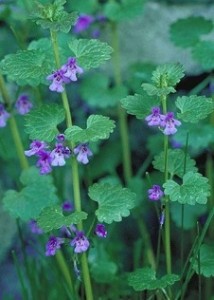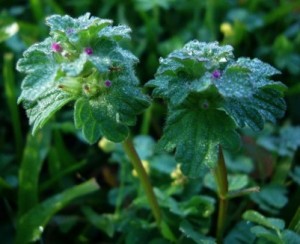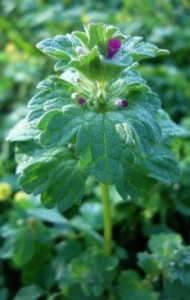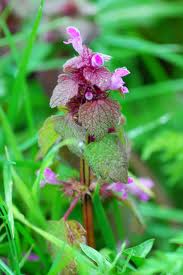Henbit: Springtime Salad Green and More
It was a zig and a zag for me. I heard the name as an edible for many years and saw the plant often but never put the two together until one spring I was picking chickweed and saw this plant yet again and decided to look it up then give it a try. Now it is one of those great little edibles of spring.
The henbit is a member of the mint family. If you remember from my first blog and my second video all mints that smell like a mint and look like a mint are edible, but they must do both. There are a lot of mints that do not smell minty, some of them are edible and some of them are not. In fact, some of the mints can make you ill. Henbit does not smell minty, but it is an edible mint. By they way, there are no poisonous look alikes. As for toxicity, we’re safe but it has causes “staggers” in sheep, horses, and cattle.
Its botanical name, Lamium amplexicaule (LAM-ee-um am-plex-i-kaw-lee) causes much confusion. As usual, there isn’t much problem with the species name, amplexicaule, which means “clasping” or in this case how the leaves grab the stem. It’s the genus name, Lamium, that causes problems. Most writers say it is Greek through Latin then define it to means a thin layer, plate or scale, or in this case the corolla tube between two lips. Unfortunately, that is not correct. And at this point remember that another common name for Henbit is Giraffe Head.
“Lamina” is Latin, from which we get the English word “laminate.” It would be fine to say “Lamium” comes from the Latin word “Lamina.” But when you say it comes from Greek Lamium would come from a totally different word, “Lamia.” “Lamia” was the name of grotesque creatures in Greek mythology and means “female man-eater.” The little flower can resemble creatures, if you have an imagination.
The common name, Henbit, is like chickweed and comes from watching chickens liking it. They’re not alone. Humming birds like it, too, but for nectar, and Henbit can be used for erosion control.

Henbit can sometimes be confused with Purple Dead Nettle, above, which is also edible. The difference in the two can be seen in the leaves. Henbit has heart-shaped leaves with big scalloped edges that grow along the entire length of the stem. The Purple Dead Nettle (dead in this case means not stinging) has more triangular shaped leaves that grow in a big clumps. Both are very nutritious, high in iron, vitamins and fiber. The seeds of the Purple Dead Nettle, Lamium purpureum, (LAM-ee-um per-PER-ee-um) have antioxidants and presumably the L. amplexicaule would as well.
As an aside, I have a tenuous connection with Lamium purpureum. Purpureum is Latin for purple, and of course, was taken from a Greek word for a particular shellfish. In Roman times purple dye was extremely expensive, and only the royal family and senators and the like could afford it. It was expensive because the dye had to be collected from tiny saltwatershellfish in Greece, the porphyra. More so, only the miniscule anal gland of porphyra had the purple dye so it took tens of thousands of them to make enough dye to dye clothes. (It does make one wonder who noticed the purple color in the first place.) In
Don’t confuse henbit with Ground Ivy, Glechoma hederacea, above left, which has much larger flowers. It, however, is also edible is small amounts, raw or cooled, and the leaves are used for tea. Ground Ivy leaves are also made into aromatic sauces.
Chop four cups of shoots, cover with water, boil 10 minutes. In a separate pan melt three tablespoons butter, add one teaspoon curry powder, two whole cloves, and a quarter teaspoon of ground cinnamon. Stir and cook for one minute, stir in two tablespoons of flour and cook one more minute. Add a half a cup of boiling water from the Henbit, stir until smooth. Drain and add the boiled Henbit and 3.4 cup sour cream. Cook on low for 15 minutes.
Green Deane’s “Itemized” Plant Profile
IDENTIFICATION: Multiple square stems from a taproot, to six to eighteen inches, purplish near bottom, greenish near stop. above. spreads indefinitely in all directions, leaves opposite, hairy, scalloped, flower pale pink to purple to red, spotted on lower lip, no aroma, tiny purple hairs on the upper part of the flowers. Don’t mistake for ground ivy which is hairless.
TIME OF YEAR: Springtime in temperate climes, February and March in Florida, found throughout North America into arctic circle.
ENVIRONMENT: Waste ground, lawns, cultivated fields, pastures, roadsides, railroads, can created a bed of purple. Tolerates most soils and conditions. Can grow under shrubs where grass won’t.
METHOD OF PREPARATIOIN: Young leaves, raw or cooked, added to salads or as a potherb. No poisonous look alikes. Stems and flowers are edible, too.





